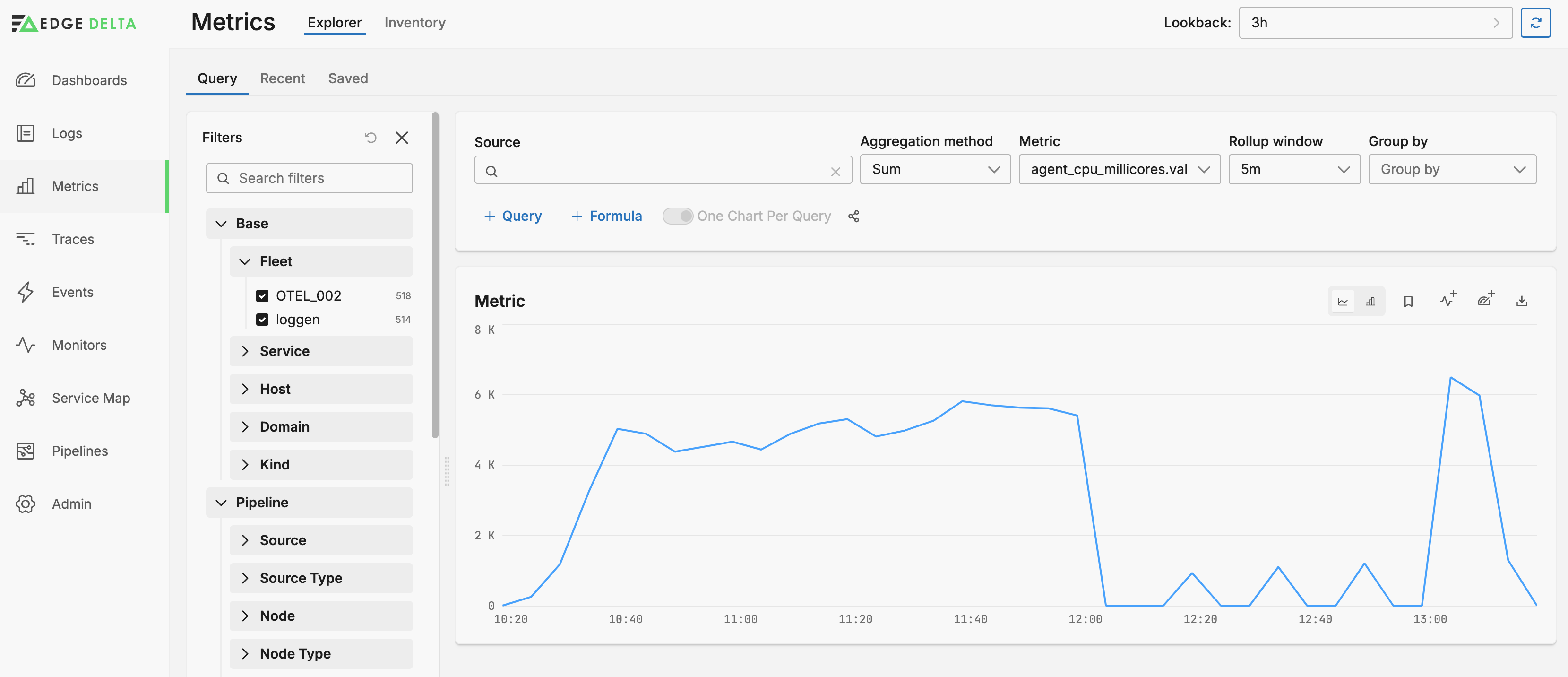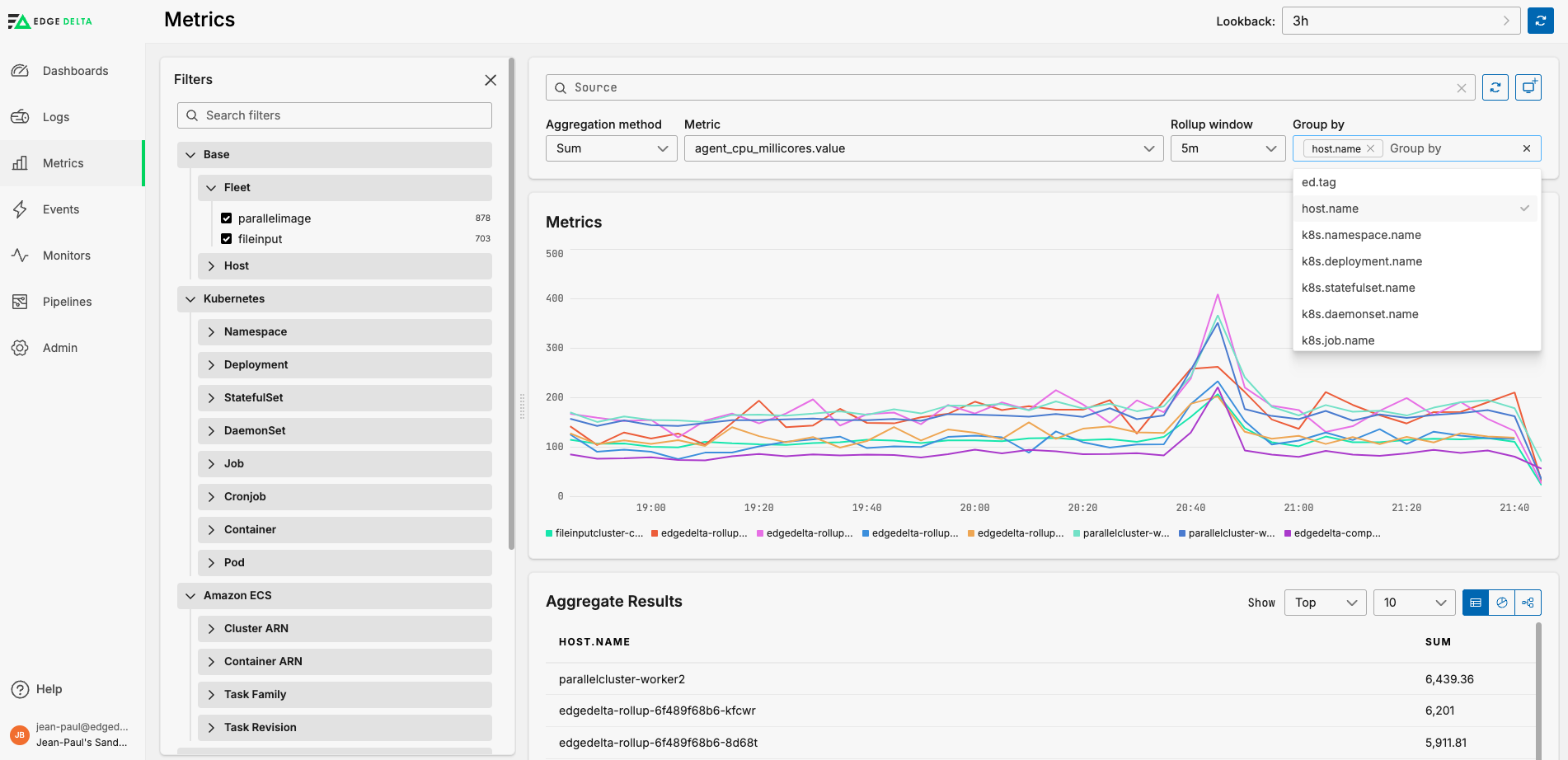Edge Delta Metrics Explorer
4 minute read
Overview
The Metrics page displays the outputs and values of all metrics ingested and created by Edge Delta, including Kubernetes scraped metrics, metric processing nodes, metric source nodes, and derived metrics.
Metrics have the following prerequisites:
- To ingest Kube State Metrics, KSM must be deployed in the same cluster as the Edge Delta agent.
- To ingest node-exporter metrics, node-exporter must be deployed in the same cluster as the Edge Delta agent.
- All metric processing nodes, such as logs to metrics nodes, must be connected to the Metrics destination node.
The Edge Delta agent uses eBPF to collect network metrics. Therefore, the following Kubernetes environment configuration is required for Kubernetes network metrics and eBPF to work:
- Linux kernel version 5.8 or later.
- Linux kernel built with the
CONFIG_DEBUG_INFO_BTF=yandCONFIG_DEBUG_INFO_BTF_MODULES=yflags.
To check for the flag:
docker run -it --rm --privileged --pid=host ubuntu nsenter -t 1 -m -u -n -i sh -c 'cat /proc/config.gz | gunzip | grep CONFIG_DEBUG_INFO_BTF'
The output should show CONFIG_DEBUG_INFO_BTF=y and CONFIG_DEBUG_INFO_BTF_MODULES=y.
In the case of minikube, the agent can run on minikube with the Docker driver. Docker must be at least v26.0.0 (Docker Desktop v4.29.0) and it is started as follows:
minikube start --driver docker
If you want to disable eBPF:
- Delete the Kubernetes Traffic source node.
- Disable the tracer:
Helm
Rerun the Helm upgrade command with the --set tracerProps.enabled=false flag.
Kubectl Update and re-apply the kubernetes manifest with the following parameter change:
ED_ENABLE_TRAFFIC_TRACER = "0"
Note: The types of metrics available in the Metrics window will depend on what Input sources you’ve configured for Metrics ingestion. For example, if you have deployed a Kubernetes Metrics Input Node in a particular Agent Tag configuration then you should see the Kubernetes metrics available in the Metric Name dropdown box, such as
ed_k8s_metric_container_network_receive_packets. For a complete list of Kubernetes metrics ingested by the Edge Delta agent, please see the kubernetes metrics source node.
Metrics
Click Metrics to view the Metrics Explorer and select a metric.

Aggregation transforms raw data into meaningful summaries by applying mathematical operations, which condenses many data points into a single, understandable figure:
- Sum: Adds up all data points over a defined period or set of records, useful for total measurements like total traffic volume.
- Average: Computes the mean value of data points, providing a general trend or typical measurement over a dataset.
- Min and Max: Identify the smallest or largest data point in the set, highlighting extremes, which can indicate unusual events or conditions.
- Count: Simply tallies the number of records or events, useful for quantifying occurrences like the number of error logs.
- Median: Finds the middle value in a sorted set of data, offering a robust measure of central tendency that is less affected by outliers.
- Count Unique: Counts distinct values in a dataset, important for identifying diversity or variety in records, like the number of unique hosts.
Filter Pane
You can filter data using the Filters pane:
- Fleet
- Host name
- Kubernetes, Amazon ECS, and Docker Resource Types
Group by
You can group the graph by any of the facets listed in the Filter Pane using the Group By option. For example, you may want to see a particular metric from all hosts on a single graph.

Add Facet
If the metric you select has multiple dimensions you can create a custom facet to group by. For example, suppose you have a log to metric node that captures the average latency per HTTP method and generates a metric like the following:
{
"_stat_type": "avg"
"_type": "metric"
"attributes": {
"method": "GET"
}
"gauge": {
"value": 1051
}
"kind": "gauge"
"name": "latency_per_method_latency.avg"
"resource": {...}
"start_timestamp": 1714124367305
"timestamp": 1714124427305
"unit": "1"
}
The dimension method is captured as an attribute, and in this instance the average latency is for the GET method.
- Click the three dots on any facet group and select Create Facet.

- Specify the dimension name prefixed with an
@character, in this instance@method.

With the multi-dimension metric specified in the Metric field, you can select the facet in the Group By list, and you can filter by the facet in the Filters pane.

Create a Monitor
You can create a monitor alert based on the selected filters. Click Create Monitor. Metric Alerts will be available in the Monitors tab in the Edge Delta UI and appear as type metric-alert.
